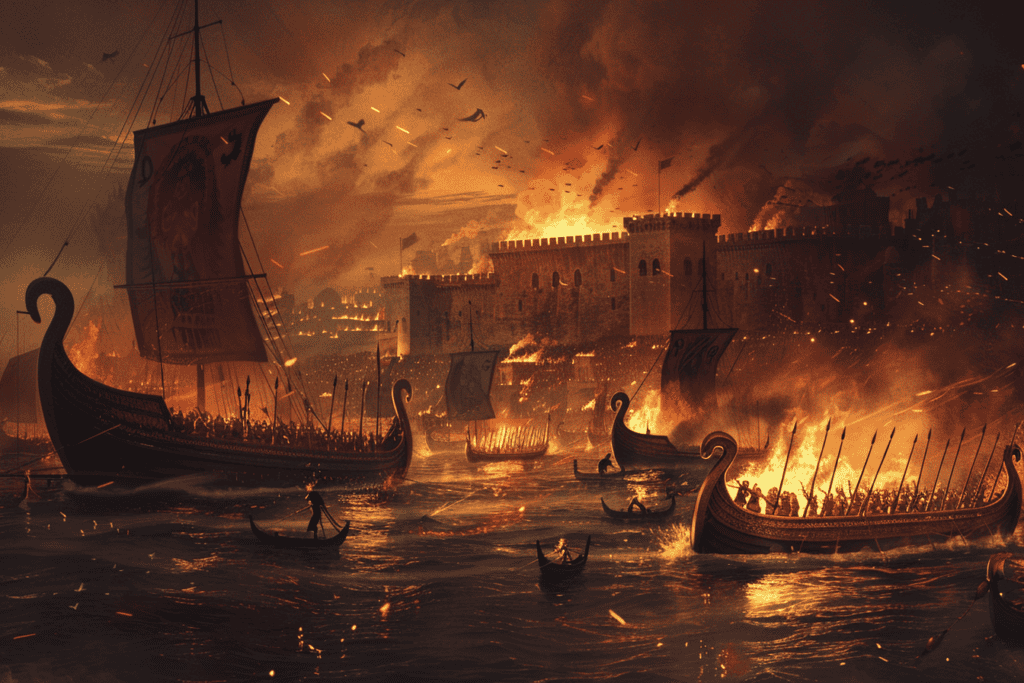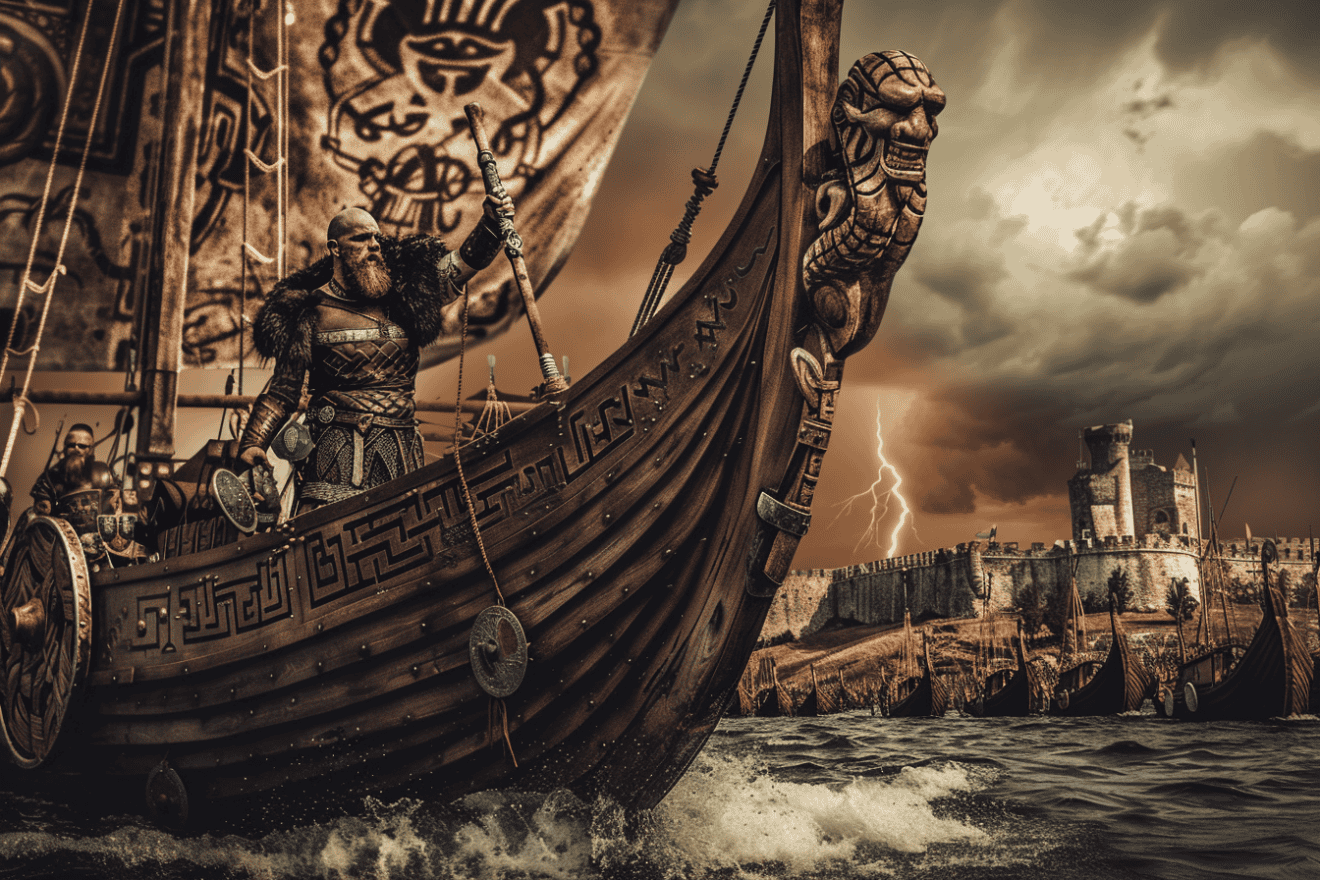The Viking Age was a period of great expansion for the Scandinavian people, who ventured far beyond their homelands to raid, trade, and settle in new territories.
Among their many conquests was the Byzantine Empire, which they first encountered in the mid-9th century.
The Viking Siege of Constantinople in 860 was the Rus’ first strike on Byzantium, and it marked the beginning of a long and complex relationship between the two peoples.

According to historical accounts, the Viking siege of Constantinople in 860 was a dramatic event that caught the Byzantines off guard.
The Rus, a group of Scandinavian traders and warriors who had established a presence in the region, launched a surprise attack on the city with a fleet of 200 ships.
The Byzantines were initially overwhelmed by the sheer size of the Viking force, which was estimated to number as many as 20,000 men.
Despite their initial success, the Vikings were ultimately unable to breach the walls of Constantinople, and they eventually withdrew from the city.
However, the siege marked the beginning of a new era of interaction between the Rus and the Byzantines, which would continue for centuries to come.
In the following sections, we will explore the historical context of the Viking Siege of Constantinople and the impact it had on the relationship between the Rus and Byzantium.
Historical Context – The Rise of the Rus and Their Expansion

The Viking Age saw the rise of the Rus, a group of Norse warriors who ventured eastwards to establish settlements and trade routes.
They eventually formed the Rus’ Khaganate, a state in present-day Russia that comprised a cluster of city-states. The Rus’ expansion into the east was facilitated by their mastery of shipbuilding and navigation, which allowed them to traverse the Baltic and reach the Black Sea.
Byzantine Empire at the Time of the Siege
At the time of the Viking Siege in 860, the Byzantine Empire was under the rule of Michael III, who had ascended to the throne at the age of two.
Michael III was a weak ruler who relied heavily on his advisors, which allowed the aristocracy to wield considerable power. The Byzantine Empire was also engaged in the Arab–Byzantine Wars, a series of conflicts with the Abbasid Caliphate that had weakened the empire’s military and financial resources.
The Rus had established a trading relationship with Byzantium prior to the Siege. The Byzantine Empire was a major trading partner for the Rus, who exchanged furs, honey, and slaves for Byzantine luxury goods such as silk and spices.
The Rus also participated in the slave trade, capturing Slavs from the Eurasian Steppe and selling them to Byzantium. The Byzantine Empire saw the Rus as a valuable trading partner, but also as a potential threat to their security.
The Rus’ Khaganate had also formed alliances with the Khazars, a Turkic people who controlled the trade routes between the Black Sea and the Caspian Sea. The Khazars were rivals of Byzantium, and their alliance with the Rus posed a threat to the empire’s southern flank.
The Siege of Constantinople in 860 – The Surprise Attack and Initial Incursions

On June 18, 860, the Viking fleet of 200 ships emerged from the Bosporus, the narrow strait connecting the Sea of Marmara to the Black Sea, to assault Constantinople.
The surprise attack caught the Byzantine defenders off guard, and as many as 20,000 Vikings surged ashore. The suburbs of the city were pillaged, and monasteries were burned down.
The pillaging continued for a few days until the Byzantine defenders could gather their forces and launch a counter-attack.
The Byzantine navy, along with the Varangian Guard, managed to push back the Viking ships and prevent further incursions.
Under the leadership of Emperor Michael III and City Prefect Nicetas Oryphas, they implemented various defensive strategies to resist the Viking siege.
The walls of Constantinople were fortified, and Greek fire, a highly effective incendiary weapon, was used to repel the Viking ships.
The Byzantine resistance was further bolstered by the miraculous intervention of the Theotokos, who was believed to have appeared on the city walls, inspiring the defenders to fight with renewed vigor.
Spiritual and Cultural Impact of the Siege

The Viking Siege of Constantinople in 860 had a profound spiritual and cultural impact on both the Byzantine Empire and the Viking world.
The event was seen as a punishment from God for the sins of the Byzantines and led to a renewed emphasis on religious piety.
The Vikings, on the other hand, were impressed by the wealth and sophistication of the Byzantine Empire and began to see themselves as part of a wider world that extended beyond their own shores.
This newfound awareness would eventually lead to the establishment of the Varangian Guard and the Viking Rus’ trading with Constantinople.
Aftermath and Legacy – The Political Repercussions for the Byzantine Empire
The Viking siege of Constantinople in 860 had significant political consequences for the Byzantine Empire.
The attack was a surprise, and the Byzantine navy was unprepared for the Viking raiders. The Vikings were able to plunder and loot the imperial capital, including the renowned Hagia Sophia.
The Byzantine sources describe the Viking raiders as being fierce and brutal, causing widespread destruction and terror. The raiders took with them vast amounts of plunder, including furs, silver, iron, wood, and slaves.
The Byzantine Empire was forced to strengthen its naval defenses and improve its intelligence gathering to prevent future attacks. The attack also led to the establishment of the Varangian Guard, a group of elite Viking warriors who served as the personal bodyguards of the Byzantine Emperor. The Varangian Guard would play a significant role in Byzantine politics and warfare for centuries to come.
Influence on Viking and Rus’ Ventures in Eastern Europe
The Viking siege of Constantinople in 860 was a turning point in the history of Eastern Europe. The raiders demonstrated the vulnerability of the Byzantine Empire and the potential for plunder and conquest in the region.
The Vikings and Rus’ continued their raids and conquests in Eastern Europe, establishing trading posts and settlements along the rivers Dnieper and Dniester.
The Viking and Rus’ ventures in Eastern Europe were influenced by their interactions with the Byzantine Empire.
The Vikings and Rus’ were exposed to new goods and technologies, such as silk, wine, and spices, which they could trade for furs and honey.
The Vikings and Rus’ also learned new military tactics and strategies from the Byzantine navy and army.










Add Comment